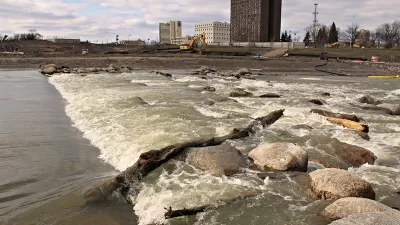The death toll from the torrential rains in Chennai, capital of Tamil Nadu state, and the surrounding region has climbed to 345 as of Dec. 4. While the scope of the rains are unprecedented, poor urban planning has been linked to the devastation.
"India's fourth-largest city, Chennai has boomed in the 21st century as a center for vehicle factories and IT outsourcing," writes Sanjeev Miglani for Reuters. "But trash-filled drains and building on lake beds in the rush to industrialization and prosperity has made it more prone to flooding."
"The floods have displaced about 1 million people in the Chennai area," according to a local reporter, writes Parth M.N. for the Los Angeles Times. Neglect of water storage may have contributed to the devastation.
(E)xperts believe poor city planning has magnified the devastation caused by a natural disaster. Many have gone a step further and called it a man-made disaster.
The head of Indian Meteorological Department, Laxman Singh Rathore, said (Dec. 2) that the flooding occurs because there is not enough space for the water to drain out, catchnews.com reported. In recent years, Chennai’s network of lakes, rivers, canals, wetlands and marshlands that previously absorbed rainwater or diverted it to the sea have been replaced by housing, malls, universities and businesses.
Chenai did not learn from Mumbai floods.
"Chennai has destroyed its water bodies the same way Mumbai had. Now Mumbai's disaster from a decade ago is repeating in Chennai," Himanshu Thakkar of the South Asian Network for Dams, Rivers, and People said, referring to the 2005 deluge in India’s booming financial capital, which left more than 1,000 people dead.
Sourjya Bhowmick writes in Catch that "mindless urbanisation, not rainfall, is behind Chennai floods."
At the start of the 20th century, Chennai had about 150 water bodies, big and small, around the city. Presently, only about 27 water bodies exist.
As the effects of climate change intensify, managing solid waste, improving drainage and afforestation need to be prioritised.
Nihar Gokhale, also of Catch, writes what can be done to prevent future floods. He points directly to urban planners in one solution: "Protect natural drainage systems."
India's urban planners often don't take water into account. In fact, water systems are blatantly destroyed.
In Chennai, for example, the local train network was expanded by erecting elevated tracks on the 25-metre wide Buckingham canal. This cut the canal's width to 10 metres and, thereby, greatly diminished its capacity to carry water into the Bay of Bengal.
"Clearly, indiscriminate development and shoddy urban planning have led to the floods in India's fourth most populous city," concludes Nityanand Jayaraman, a Chennai-based writer and social activist in his piece for the BBC News.
FULL STORY: Death toll climbs to 269 from torrential rain and flooding in southern India

Montreal Mall to Become 6,000 Housing Units
Place Versailles will be transformed into a mixed-use complex over the next 25 years.

Planetizen Federal Action Tracker
A weekly monitor of how Trump’s orders and actions are impacting planners and planning in America.

DARTSpace Platform Streamlines Dallas TOD Application Process
The Dallas transit agency hopes a shorter permitting timeline will boost transit-oriented development around rail stations.

Bend, Deschutes County Move to Restrict Major Homeless Encampment
City and county officials are closing off portions of an area known as Juniper Ridge where many unhoused residents find shelter, hoping to direct people to housing and supportive services.

High Housing Costs Driving Down Transit Ridership in LA
When neighborhoods gentrify and displace lower-income residents, transit ridership suffers, new research shows.

Iowa Legalizes Accessory Dwelling Units
A new law will allow property owners to build ADUs on single-family lots starting on July 1.
Urban Design for Planners 1: Software Tools
This six-course series explores essential urban design concepts using open source software and equips planners with the tools they need to participate fully in the urban design process.
Planning for Universal Design
Learn the tools for implementing Universal Design in planning regulations.
City of Mt Shasta
City of Camden Redevelopment Agency
City of Astoria
Transportation Research & Education Center (TREC) at Portland State University
City of Camden Redevelopment Agency
Municipality of Princeton (NJ)
Regional Transportation Commission of Southern Nevada





























